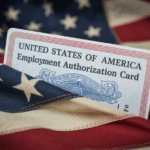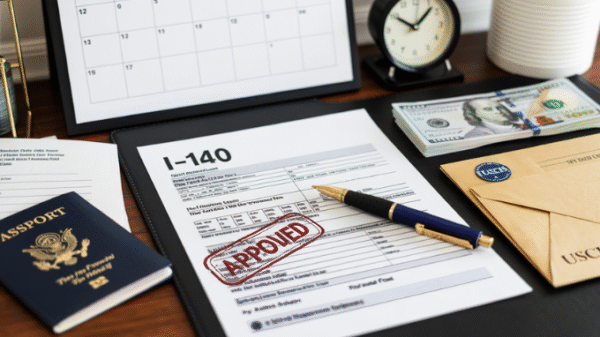PERM might sound like just another immigration form, but it’s actually one of the most time-sensitive and employer-driven parts of the green card journey. If your PERM is filed late or done incorrectly, your entire EB-2 or EB-3 case could be delayed — or even denied.
For H-1B visa holders who are on a 6-year time limit, this step needs to be planned strategically. In fact, many smart employers begin the PERM process in the second or third year of your H-1B, just to be safe. Why? Because the green card process after PERM (I-140 and I-485) also takes months to years — and your H-1B clock keeps ticking.
Unlike some other steps in the immigration process, PERM is handled entirely by your employer — you can’t file it yourself. It includes detailed job market testing, like running classified ads and documenting why no U.S. worker could be hired for the position.
It’s also worth noting that PERM doesn’t give you any immigration status or work benefits by itself. It’s a back-end requirement — but without it, you can’t even start the formal green card application. That’s why it’s critical to understand each phase of the process.
🧭 What is PERM Labor Certification?
PERM stands for Program Electronic Review Management, a system run by the U.S. Department of Labor (DOL). Before your employer can sponsor you for a green card under EB-2 or EB-3, they must prove to the government that:
- The job you’re being offered cannot be filled by a qualified U.S. worker, and
- You’re being paid at or above the prevailing wage for that role in your geographic area
This certification ensures that foreign workers aren’t undercutting American wages or job opportunities. It’s not just a formality — it’s a multi-month legal process that requires detailed job descriptions, formal advertising, and strict timelines.
Step-by-Step: PERM Process Explained
Before your employer can even begin your green card application through the EB-2 or EB-3 category, they must first complete the PERM process. This isn’t a single form or submission — it’s a series of steps that involve job analysis, wage requests, advertisements, and finally, an official filing with the U.S. Department of Labor (DOL).
Each step is tightly regulated and time-bound. If your employer skips a step, doesn’t document it correctly, or makes a mistake, it can lead to delays of several months — or even a denial. That’s why employers usually rely on immigration attorneys to handle it from start to finish.
It’s also important to understand that PERM isn’t about proving that you’re qualified — it’s about proving there isn’t a qualified U.S. worker available to take the job. That’s why the process includes job advertising and prevailing wage requirements.
Let’s break the PERM process down step by step so you can understand what’s happening behind the scenes — and how long each phase really takes.
Step 1: Job Description & Role Requirements
The employer must create a detailed job description including required education, experience, skills, job duties, and worksite location. This job description will form the basis for the entire PERM case.
It must be drafted carefully — if it’s too generic, the DOL might assume U.S. workers could qualify. If it’s too narrow, it may seem like the job was “customized” just for you. Immigration attorneys often review this in-depth to balance compliance with real hiring needs.
Step 2: Prevailing Wage Determination (PWD)
The employer then submits a request to the DOL’s National Prevailing Wage Center to determine the minimum salary for the job based on location, job title, and required experience.
This can take 2–3 months or more. The employer must agree to pay at least this wage when the green card is approved — regardless of what you’re earning now.
Step 3: Recruitment Campaign
This is the most hands-on phase. The employer must advertise the job across specific platforms including:
- 2 Sunday print ads in a local newspaper
- A State Workforce Agency (SWA) job posting
- A company website posting
- And 3 additional recruitment methods (e.g., job boards, campus recruiting, radio ads, etc.)
Once all ads are completed, the employer must wait 30 days and review any applicants, documenting why none were qualified. This part is very sensitive — sloppy documentation or rejection reasoning could lead to a PERM audit.
Step 4: Filing ETA Form 9089
After recruitment is complete and no qualified U.S. workers are found, the employer submits Form ETA 9089 to the DOL. This is the actual PERM application.
It includes full job details, recruitment efforts, wage offered, and worker qualifications — all under penalty of perjury. The form can be submitted electronically or via mail (though electronic is far more common and faster).
Step 5: DOL Review & Decision
The DOL will review the form and either approve, audit, or deny the case. Audits can be random or triggered by specific job factors (we’ll cover that later).
Without an audit, the review can take 3–5 months. If audited, the case may take 6–10 months or more.
⏱️ PERM Timeline: How Long It Really Takes (2025 Estimates)
One of the most frustrating parts of the PERM process is how long it can take — especially when you’re on a ticking H-1B clock. Many applicants and employers assume it’s a quick form submission, but in reality, PERM involves months of preparation, mandatory waiting periods, and unpredictable government processing times.
The total timeline can vary depending on whether your case is audited, how fast your employer moves, and how soon you begin. Starting early is essential — waiting until your 5th or 6th year of H-1B can leave little room for delays or appeals.
It’s also worth noting that while PERM itself has no filing fee, it demands internal company resources, coordination with attorneys, and consistent follow-ups. Delays in just one stage — like Prevailing Wage Determination — can push your case back by months.
Here’s a breakdown of how long each stage typically takes in 2025:
📊 PERM Timeline Breakdown
| Stage | Estimated Time (No Audit) | With Audit |
| Prevailing Wage Request | 2–3 months | — |
| Recruitment & Advertising | ~2 months | — |
| Post-Recruitment Waiting | 30 days | — |
| DOL Review & Decision | 3–5 months | 6–10 months |
| ⏱️ Total Time | 6–10 months | 10–16+ months |
Keep in mind that even once PERM is approved, you only have 180 days to file the next step: the I-140 petition. Missing that window means starting the whole PERM process over.
How Much Does PERM Cost?
While PERM labor certification doesn’t require a government filing fee, that doesn’t mean the process is free. In fact, it can be one of the most expensive parts of the green card process for your employer — not because of the government, but due to required legal and advertising steps.
It’s important to understand that U.S. immigration law mandates that the employer must cover all PERM-related costs. You, the beneficiary, are not allowed to pay for any part of the PERM process, including attorney fees or job ads. If you do, it could result in the denial of your green card later.
Despite there being no fee paid directly to the Department of Labor, the real cost lies in attorney support, recruitment advertising, and HR coordination. Employers often work with immigration law firms to handle PERM filings due to the legal complexity and the high risk of audits.
Let’s break down the estimated costs:
Typical PERM Costs for Employers (2025)
| Category | Estimated Cost | Notes |
| Government Filing Fee | $0 | PERM has no direct DOL filing fee |
| Immigration Attorney Fees | $3,000 – $6,000 | Covers job analysis, PWD, ads, ETA 9089, filing support |
| Required Recruitment Ads | $2,000 – $4,000+ | Includes newspaper ads, SWA posting, 3 additional methods |
| Internal HR/Admin Costs | Varies | Interviewing, documentation, and compliance review |
| Total Estimated Cost | $5,000 – $10,000+ | Paid entirely by employer (by law) |
Some large tech companies have in-house legal teams, which may reduce legal costs. But most small to mid-sized companies rely on external attorneys to handle the process properly.
PERM Audits: What Triggers Them?
Even if your employer follows every step of the PERM process correctly, your case might still get audited. That’s because the U.S. Department of Labor (DOL) conducts both random and targeted audits — and they can significantly delay your green card process by 6 to 10+ additional months.
An audit isn’t necessarily a rejection. Think of it as a request for deeper proof — the DOL wants to verify that the job ads were real, the recruitment was fair, and the employer genuinely couldn’t find a qualified U.S. worker. But the stakes are high: a poorly prepared audit response can result in a denial and force you to restart the entire process.
Many audits are triggered not by mistakes, but by red flags in the job role, recruitment process, or company practices. Employers must keep detailed records — including resumes of all applicants, interview notes, and internal memos — for years after filing the PERM.
If you’re on an H-1B and nearing your max-out date, an audit can seriously impact your timeline. That’s why it’s essential to know what increases the risk.
Common PERM Audit Triggers
- Overly specific or restrictive job requirements
(e.g., asking for tools, languages, or degrees not typically needed in the role)
- Remote work / telecommute jobs
These are reviewed more strictly due to changing labor market dynamics
- Multiple PERM filings for similar roles
If a company files for many foreign workers in the same position, DOL may flag for review
- Prior PERM denials or compliance issues
Employers with a history of issues are more likely to be audited again
- Suspicious timing or recruitment gaps
Delas or inconsistencies in recruitment steps can raise red flags
Types of Audits
| Type | What It Means |
| Random Audit | Chosen at random for compliance check |
| Targeted Audit | Based on potential issues or red flags found |
Can PERM Denials Be Appealed?
Yes. If PERM is denied (with or without audit), the employer can:
- File a Request for Reconsideration
- Appeal to the Board of Alien Labor Certification Appeals (BALCA)
- Or restart the process from scratch (often the faster option)
❌ Common Mistakes That Cause Delays or Denials
The PERM process is highly procedural. Even small mistakes — a missed deadline, a vague job description, or improperly documented recruitment — can delay your green card process or cause a denial. Unfortunately, most of these mistakes happen before the actual form is filed, making them hard to fix after the fact.
For H-1B workers, these delays can be risky. If your H-1B clock is ticking toward the 6-year limit and your PERM gets denied or audited due to an avoidable error, you may have to leave the U.S. or file for extensions based on a weak case. That’s why both employers and employees need to stay vigilant from day one.
Some errors come from miscommunication — like when the employer lists incorrect minimum job requirements that don’t align with the actual role. Others are legal missteps, such as paying for PERM-related costs out of your own pocket, which is strictly prohibited.
Let’s go over the most common (and most avoidable) issues that derail PERM cases.
1. Vague or Overly Broad Job Descriptions
If the job role doesn’t clearly outline the required skills and experience, the DOL may assume many U.S. workers are qualified. That can trigger a denial or audit.
2. Inflated or Unrealistic Job Requirements
Some employers try to make the role seem harder to qualify for — thinking it’ll reduce U.S. applicants. But this backfires. If the requirements seem “tailor-made” for you, it can trigger an audit or denial.
3. Errors in Prevailing Wage Request
If the job title doesn’t match industry norms or if the employer inputs incorrect responsibilities, the wage determination can be rejected — adding 2–3 months of delay.
4. Recruitment Not Properly Documented
Employers must show proof of every step in recruitment — including ad copies, rejection letters, and resumes of U.S. applicants. Failure to produce this if audited = automatic denial.
5. Timing Violations
The recruitment process must follow a strict timeline:
- Ads can’t be too old or too new
- The ETA 9089 must be filed within 180 days of the first ad
- The 30-day quiet period after recruitment must be observed
One missed date = entire process may need to restart.
PERM Approval: What Happens Next?
Getting your PERM approved is a major milestone, but it’s not the end of the process — in fact, it’s only the first third of the employment-based green card journey. Once PERM is certified by the Department of Labor, your employer has 180 days to move forward by filing Form I-140 with USCIS.
What’s important to remember is that PERM approval doesn’t give you any new work rights, legal status, or immigration benefits. It’s purely a labor market certification that allows your green card case to proceed. If your employer misses the filing deadline after approval, the entire PERM process has to be redone from scratch — and you lose valuable time.
Many H-1B holders mistakenly think a PERM approval “locks in” their green card, but it doesn’t. Until USCIS approves the I-140 and your priority date becomes current, your immigration status is still tied to your nonimmigrant H-1B.
Let’s look at what exactly comes next once you’ve cleared this first hurdle.
PERM Certification Validity
- Once approved, your PERM is valid for 180 calendar days
- Your employer must file the I-140 Immigrant Petition within that window
- Missing the deadline = full restart of PERM process
Next Step: Filing Form I-140
- Filed with USCIS, not DOL
- Proves your employer can pay the wage and that you qualify for the job
- You can use premium processing to speed this up (15 days)
Priority Date Is Set
- Your priority date is the date the PERM was filed (not the date it’s approved)
- This date determines your place in line on the visa bulletin for I-485 filing
Switching Employers? Be Careful
- PERM is employer- and job-specific — you can’t take it to a new company
- Changing jobs = starting PERM all over unless I-140 is approved and you qualify for AC21 portability
Conclusion
PERM Labor Certification may seem like just one step in the green card journey, but in reality, it’s the foundation that everything else depends on. From setting your priority date to proving there are no qualified U.S. workers for your role, PERM is where your green card case truly begins.
While it doesn’t give you a new immigration status or benefits, a well-executed PERM application can keep your path to permanent residency smooth, legal, and on time. On the other hand, mistakes, audits, or missed deadlines can easily cost you months — or even force a full reset of the process.
For H-1B holders especially, starting early and working with experienced legal support is key. Make sure your employer understands the timelines, costs, and documentation requirements — because when PERM is done right, the rest of the green card process becomes much more manageable.






